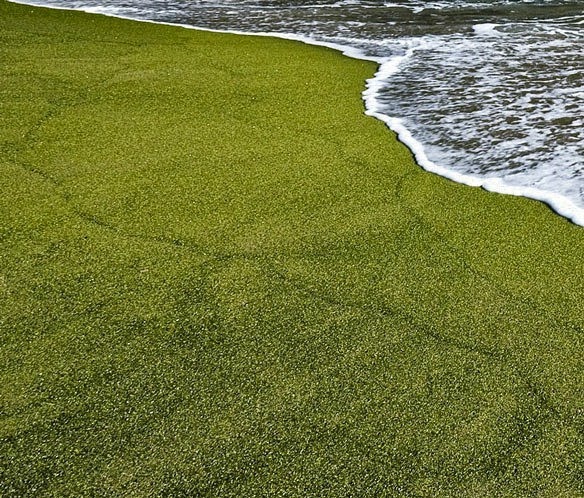Papakolea, The Green Sand Beach
Papakolea Beach, also known as Green Sand Beach or Mahana Beach, is a
green sand beach located near South Point, in the Kaʻu district of the
island of Hawaii. It is one of the only four green sand beaches in the
world, the others being in Galapagos Islands and one in Norway. The
olive-like color of the sand comes from the presence of a greenish,
semi-precious stone named olivine that comes from the cinder cone of
Pu’u Mahana, a 49,000 year-old volcano on Mauna Loa’s southwest rift,
against which the beach is located. The erosive force of the ocean
washing into the base of Pu'u o Mahana cinder cone has extracted
olivines out of the cinder and deposited them on the beach, giving the
sand a green tint.

Photo credit
Puʻu Mahana lat erupted 49,000 years ago. Since then, the cinder cone
has partially collapsed and has been eroded by the ocean. The cinder
cone is rich in olivine, a silicate mineral containing iron and
magnesium. Olivine is a common mineral component of Hawaiian lavas and
one of the first crystals to form as magma cools. Olivine is locally
known as "Hawaiian Diamond" and is notably found in Oʻahu's famous Diamond Head volcano.
Olivine is denser and tougher than other sand crystals and therefore tends to accumulate on the beach whereas the usual volcanic sand is swept out to sea. Although these crystals are eventually washed away as well, the constant erosion of the cinder cone ensures a steady supply of sand for the foreseeable future. Eventually, the supply will run out and the beach will look like any other.

Photo credit

Photo credit

Photo credit

Photo credit

Photo credit
Retrieved from Web site: Amusing Planet

Photo credit
Olivine is denser and tougher than other sand crystals and therefore tends to accumulate on the beach whereas the usual volcanic sand is swept out to sea. Although these crystals are eventually washed away as well, the constant erosion of the cinder cone ensures a steady supply of sand for the foreseeable future. Eventually, the supply will run out and the beach will look like any other.

Photo credit

Photo credit

Photo credit

Photo credit

Photo credit